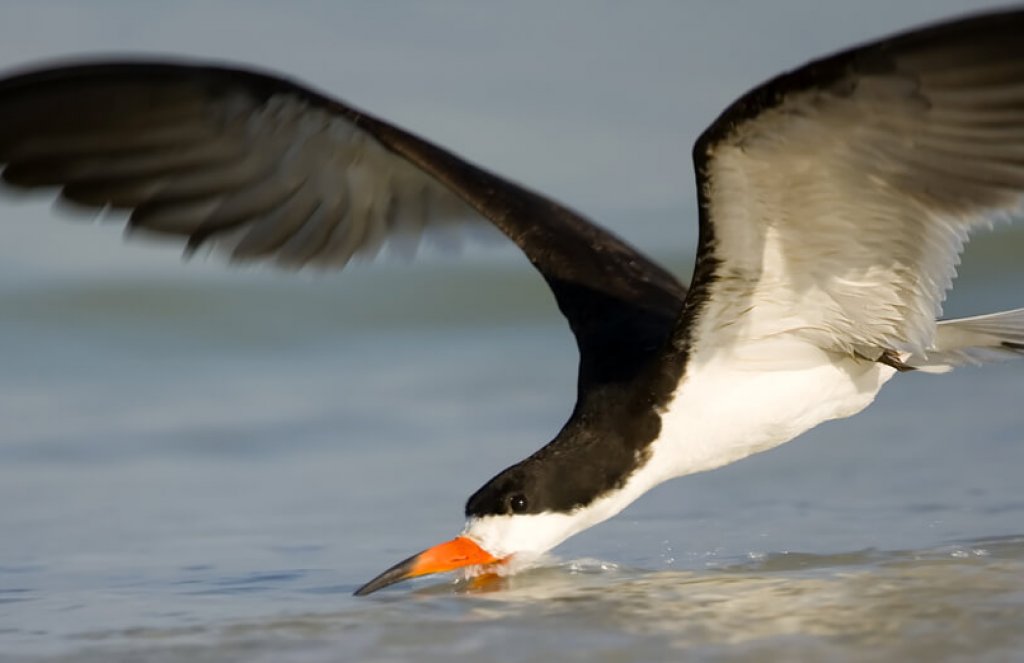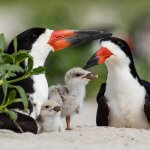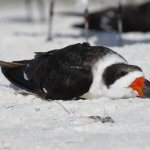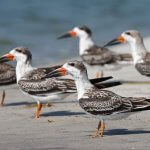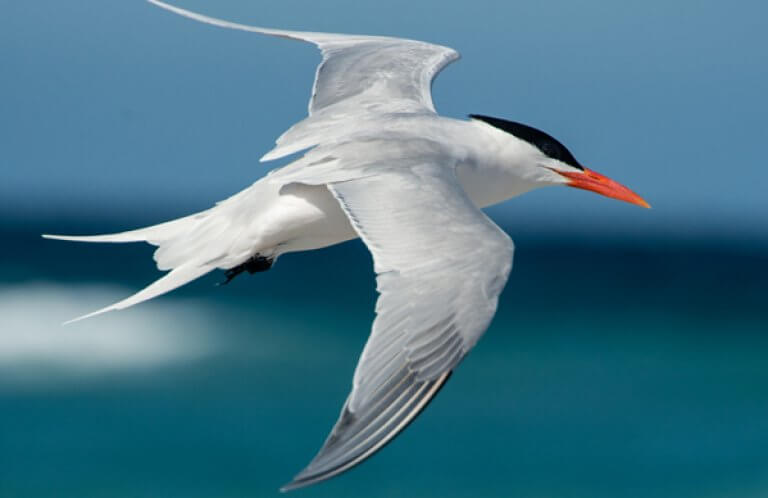About the Black Skimmer
A group of Black Skimmers in flight resembles an aerial ballet, circling, banking, and gracefully alighting as one. Although taxonomists place this long-winged waterbird in a separate genus, it's closely related to gulls and terns, including species such as the Royal, Gull-billed, and Roseate Terns.
The Black Skimmer's most striking feature is its gaudy red-and-black, laterally compressed bill, which has a lower mandible that juts out farther than does the upper. Indeed, this bird's genus name Rynchops derives from the Ancient Greek for "bill" and "face." Its unique appearance lends the Black Skimmer a number of evocative folk names, including Scissor-bill, Cutwater (Cortagua or Corta-agua in South America), and Seadog (after its calls, often compared to dog barks).
Although it may seem awkward-looking on a standing bird, the Black Skimmer's unorthodox beak arrangement makes sense once one watches this tern-like bird "skimming" for food. A feeding skimmer flies low over water with its beak open and lower mandible partially submerged. When the lower part of the bill touches prey, such as a small fish, the bill's upper mandible snaps down, securing the bird's meal.
Another unique feature of the Black Skimmer is its eyes, which have large pupils that narrow to vertical slits as do a cat's pupils. This adaptation compensates for glare off the water's surface and may enhance the bird's vision as it hunts in dim light.
Songs and Sounds
The Black Skimmer's sharp calls — kak-kak-kak — are often compared to a dog's barking.
Listen here:
(Audio: Paul Marvin, XC452970. Accessible at www.xeno-canto.org/452970 )
Black Skimmer Breeding and Feeding
The Black Skimmer is a social bird, roosting and breeding in large colonies, often alongside gulls and terns, and benefiting from the protection of their more aggressive neighbors. Successful colonies usually occupy the same nest sites each year, although skimmers will readily colonize a new site if an old one becomes unavailable.
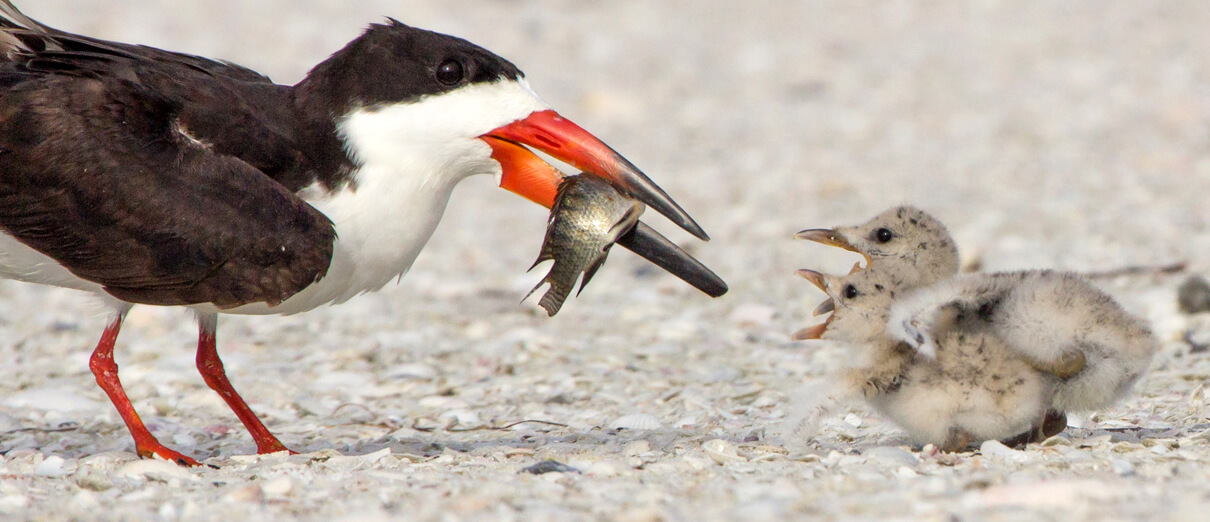
A mated pair of skimmers makes a simple scrape in the sand for a nest. Both male and female take turns incubating the typical clutch of four eggs. As with other ground-nesting birds such as the Killdeer and Piping Plover, skimmer chicks hatch with open eyes and downy juvenile plumage. Although the chicks leave the nest soon after hatching, they remain dependent upon their parents for food until they learn to hunt. Young Black Skimmers initially have "normal"-looking bills, which quickly grow to match the unequal proportions of adult beaks.
The Black Skimmer feeds mainly on small fish but also shrimp and other small invertebrates. This bird is usually a solitary hunter, preferring to forage in calm, shallow water where small fish concentrate near the surface and are easier to capture.
Black Skimmers are active at all times of day, but their activity levels peak at dawn and dusk. They can even hunt at night, using their finely tuned sense of touch to catch prey in the darkness.
Region and Range
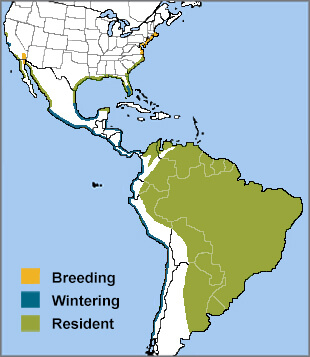
The Black Skimmer is only found in the Americas, although two related species in the same genus are found in South Asia and Africa.
There are three recognized Black Skimmer subspecies: The North American subspecies is the largest and most migratory, breeding along the Atlantic, Gulf, and lower Pacific coasts, and moving as far south as the Central and South American coasts for the winter. Some remain year-round from North Carolina's Outer Banks to Florida, and around the Gulf Coast to Mexico. Small numbers winter in parts of California as well.
Two other subspecies of Black Skimmer inhabit South America, occurring along both coasts and along interior rivers, particularly in Amazonia.
Conservation of the Black Skimmer
North American populations of the Black Skimmer are on the 2016 State of the Birds Watch List, which lists bird species at risk of becoming threatened or endangered without conservation action.
A major threat to Black Skimmers is habitat loss from coastal development and human disturbance, such as people walking or driving through nesting areas, or letting their dogs run unleashed on the beach. This species is also affected by threats to fish populations, such as oil spills or chemical pollution.
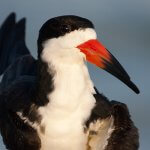
Help support ABC's conservation mission!
ABC launched a Gulf Coast conservation effort in 2012 to identify and implement protective measures for the Black Skimmer, Least Tern, Snowy Plover, and other vulnerable beach-nesting birds, including signage and fencing at colonies to reduce detrimental human recreation impacts that can lead to abandonment or nesting failures.
ABC also promotes the "Fish, Swim, and Play from 50 Yards Away" program each year, which aims to educate tourists and local residents about the needs of Black Skimmers and other imperiled bird species that nest on beaches along the Gulf Coast.
Get Involved
Policies enacted by the U.S. Congress and federal agencies have a huge impact on seabirds. You can help shape these rules for the better by telling lawmakers to prioritize birds and bird-friendly measures. To get started, visit ABC's Action Center.
Plastics pose a deadly threat to seabirds around the world. You can help seabirds by reducing your daily use of plastics. To learn more and get started, visit our Plastics page.
American Bird Conservancy and partners are creating predator-free nest sites for vulnerable seabird species, reducing fishery impacts, and much more. This is a monumental undertaking, requiring the support of many, and you can help by making a gift today.





































